Can I Get Long Term Care Insurance at Age 64
2.The Long-term care Insurance System
(1) Aims for introducing the system
- To facilitate a system in which the society as a whole support those who are facing the need of long-term care, society's major cause of concern in terms of becoming old.
- To establish a system in which the relationship between benefits and burdens are made clear, by way of introducing a social insurance approach, which can easily gain public understanding.
- To reconstruct the present vertically-divided system between health, medical and welfare services, and to establish a system by which service users can receive comprehensive services from a variety of institutions of their choice.
- To separate long-term care from coverage of health care insurance, and to establish a system which aims to decrease cases of "social hospitalization" as the first step toward restructuring the social security system as a whole.
(2) Outline of the System
- 1) Insurers
- Insurers shall be municipalities and special wards in the metropolitan area. The central government, prefectures, health care insurers and pension insurers shall provide continuous �@support and assistance to them.
2) The insured, beneficiaries and premiums
�@ Category 1 insured persons Category 2 insured persons Eligible persons Persons aged 65 or over Persons aged 40 to 64 who are insured by health care insurance Beneficiaries �E Persons requiring long-term care (bedridden, dementia) �E Persons requiring support (frail) Those who have become bed-ridden, dementia, and/or frail be- cause of specific age-related diseases such as early-stage dementia, cerebro-vascular disorder, etc. (*) Premiums Collected by municipalities Collected with premiums for health care insurance by health care insurers and paid in lump sums Method�@of levying�@and�@collection �E Fixed premiums per income bracket (premiums for persons with low incomes shall be reduced) �E Premiums shall be deducted from pension benefits above a given amount (180 thousand yen per year),otherwise they shall be collected directly by municipalities �E Employees' Health Insurance �� The amount of premiums is decided based on standardized amount of salary multiplied by long-term care premium rate (Employers bear part of the cost) �E National Health Insurance: �� The amount of premiums is decided based on the amount of income as well as fixed per-capita amount. (The government bears part of the cost) (*) For the time being, public funds will be used to provide young disabled persons with comprehensively programmed long-term care services, etc. in accordance with the Government Action Plan for Persons with Disabilities.
(3) Procedures for use
| �@�@1) | Municipalities shall provide long-term care requirement certification and support requirement certification based on the screening judgement results of the long-term care approval board. The long-term care approval board will investigate the mental and physical condition of the insured person and make a screening judgement based on the opinions of a regular doctor. (The screening judgement can be entrusted to prefectures.)
Limit for benefits paid for home long-term care services (To be unified in January 2002)
| ||||||||||||||||||||||||||||||||||||||||||||||
| �@�@2) | From the standpoint of providing comprehensive and planned service to accommodate the policyholder's demands, it is fundamental that a long-term care service plan (care plan) is decided. | ||||||||||||||||||||||||||||||||||||||||||||||
(4) Insurance benefits
| �@ | In-home service | Services at facilities | ||||||||||||||||||||||||||
| Persons requiring long-term care |
|
| ||||||||||||||||||||||||||
| Persons requiring support | Same as above (excluding care service with mutual support for the elderly with dementia) | N/A |
(5) Costs
| 1) | Out-of-pocket payment at a fixed rate (10% of the cost of the insured services) and a standard charge for meals imposed on users of facility services (such as special nursing homes for the elderly). |
| 2) | There is an upper limit of the above out-of-pocket payment. |
| 3) | The upper limit of the out-of-pocket payment and standard charge for meals is set lower for people with low income. |
| �@ | Upper limit of 10% charge covered by high long-term care service cost | Standard charges for meals |
| Non-low income persons | 37,200 yen/month | 23,400 yen/month(780 yen/day) |
| Municipal tax-exempted households | 24,600 yen/month | 15,000 yen/month(500 yen/day)) |
| Old-Age Welfare Pension recipients, etc. | 15,000 yen/month | 9,000 yen/month(300 yen/day)) |
| * | Reduction and exemption measures for costs during the 5-year period following implementation, for persons resident in special nursing homes for the elderly at the time of implementation, shall be negotiated in response to their ability to pay |
(6) Expenses
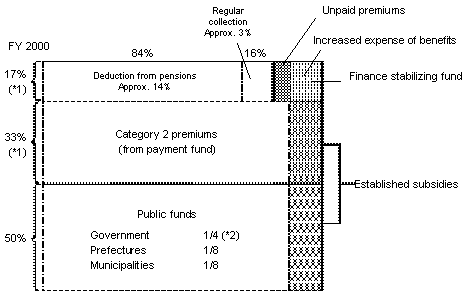
| *1 | Percentage based on the population ratio of category 1 and category 2 insured persons. | |||||||
| *2 | The government will be provided 5% to make adjustments for differences in municipalities' financial capabilities. (Percentage of subsidies are differ from each municipalities)
|
| �� | Intermittent financial management shall be introduced, and premiums for category 1 insured persons will be revised once every 3 years. |
(7) Insurance Premiums
- For the standpoint of having people bear the cost according to their ability to pay, the insurance premium of Category 1 insured people, in principle, shall be a fixed amount set by each municipality according to their income level. This reduces the burden on people with low income, meanwhile people with high income is bearing more expenses.
Level Eligible Persons Premium (Ref.) Estimated percentage of eligible persons 1 �E Public assistance recipients �E Municipal tax-exempted households and Old-Age Welfare Pension recipients Basic amount x 0.5 Approx. 2% 2 Municipal tax-exempted households Basic amount x 0.75 Approx. 29% 3 Municipal tax-exempted persons Basic amount x 1 Approx. 43% 4 Municipal tax payer (The insured person's total amount of income is less than 2,500,000 yen.) Basic amount x 1.25 Approx. 16% 5 Municipal tax payer (The insured person's total amount of income is 2,500,000 yen or more.) Basic amount x 1.5 Approx. 10%
- The insurance premium of category 2 insured people shall be calculated by the method decided by their health care insurer. (The average cost per category 2 insured person is the same.)
(8) Preparation of the basis for provision of long-term care services
| 1) | In order to promote infrastructure of a long-term care service to progress in a systematic manner, municipalities must determine their plans for long-term care insurance services and prefectures must decide on their long-term care services and benefits respectively, based on fundamental policies decided by the government. |
| 2) | When municipalities are to plan or to change the municipal long-term care insurance service plan, measures to reflect insured persons' opinions shall be taken. |
| 3) | Municipalities that have difficulty securing the standard levels of benefits for home services determined by the government, can fix a standard level that is lower than the appropriate level, and raise this gradually to the level determined by regulations 5 years after implementation. |
(9) Considerations for stabilizing system operations
��Considerations of financial aspects��
| �@�@1) | The government will provide subsidies equivalent to 50% of the administrative expenses incurred for the newly added matters of long-term care requirement certification etc. |
| �@�@2) | Finance stabilizing funds shall be granted or loaned to prefectures, (the government, prefectures and Category 1 premiums shall each provide one third of the revenues), to make good financial deficits caused by increased payments resulting from benefits surpassing estimates, and declined rates of premium payments. |
��Considerations of business implementation aspects��
- Prefectures may be entrusted with the screening judgement matters of long-term care requirement certification.
Prefectures shall support the joint establishment of screening meetings for a number of municipalities.
(10) Implementation
- April 1, 2000
(11) Considerations
- Necessary reconsideration and additional examination of the range of insured persons, levels and contents of benefits, ideal cost sharing of premiums and the long-term care insurance system in general, shall be carried out based on situational changes and social economic conditions.
- The opinions of local community groups, etc. shall be given full consideration when investigating system reforms.
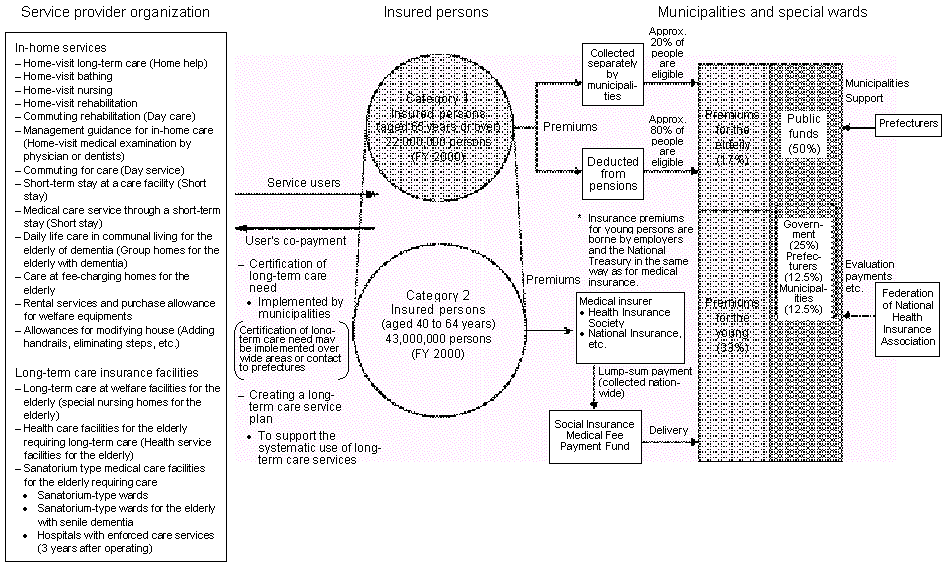
The ratio of elderly persons increases from "one out of six people" to
"one out of four people"
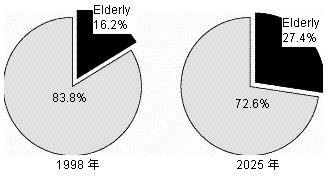
The number of bedridden elderly / suffered from
dementia are rapidly increasing
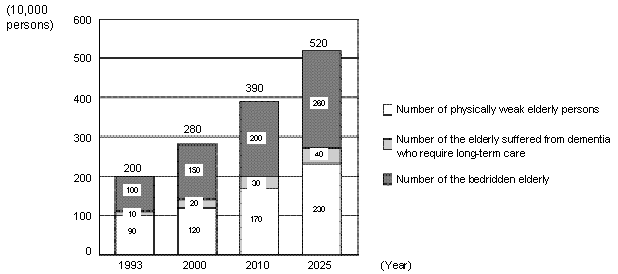
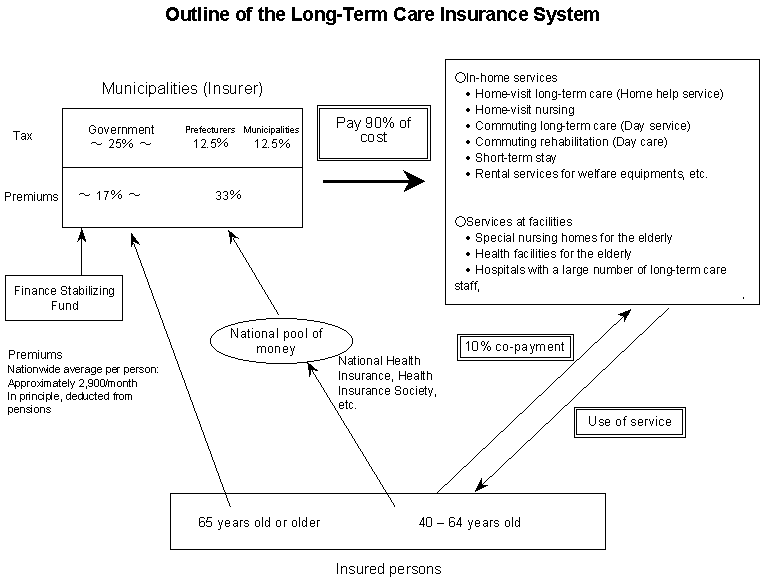
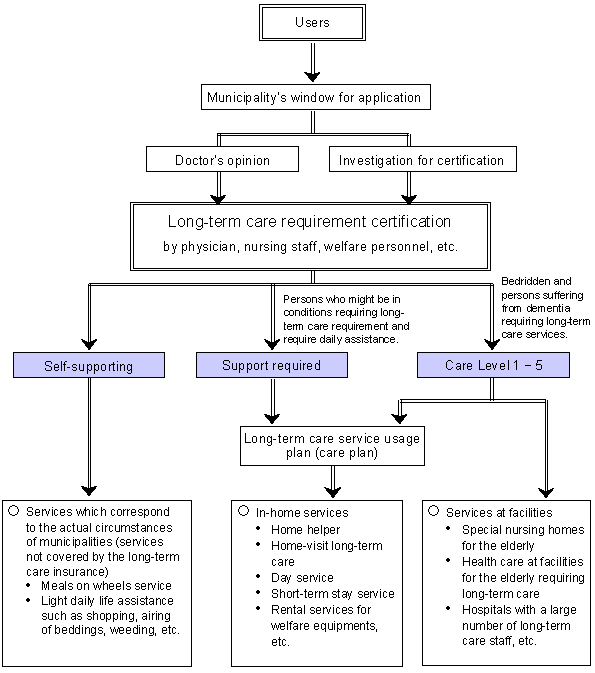
long-term care insurance system from the users' point of view
| Previous system | Long-term care insurance system | |||||||||||||||
| �� | Users can choose the type of service and facilities they want to use. | ||||||||||||||
| �� | Users will make a long-term care service usage plan (care plan) and use medical care and welfare services comprehensively. | ||||||||||||||
| �� | Services provided by various organizations such as private companies, agricultural cooperatives, livelihood cooperatives, and volunteer organizations, etc. | ||||||||||||||
| �� | Users will pay 10% charge for the service regardless of their income.
|
Finance stabilizing fund (source of revenue �� Government: prefecturers:
Category 1 premiums - 1: 1:1)
Loan etc. from fund as a result of financial deficit incurred from
increased expense of benefits and non-payment of premiums
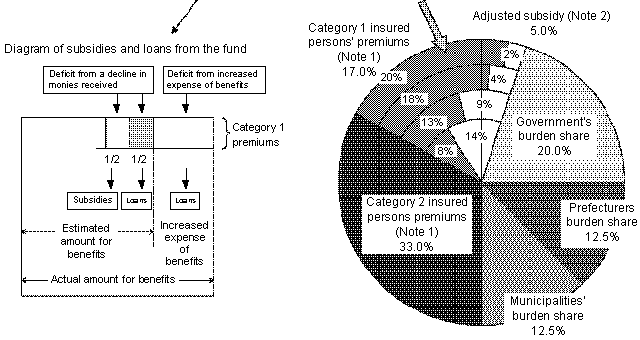
| Notes: 1. | The ratio of category 1 insured persons: Category 2 insured persons was assumed for FY 2000. |
| 2. | Adjusted subsidies will be provided in relation to the percentage of latter stage elderly persons in each municipality, and their incomes, etc. Nationwide, this will amount to approx. 5% of the overall subsidy. However, subsidy adjustment rates are examples. |
Return To Top
Index / Back / Next
Can I Get Long Term Care Insurance at Age 64
Source: https://www.mhlw.go.jp/english/topics/elderly/care/2.html